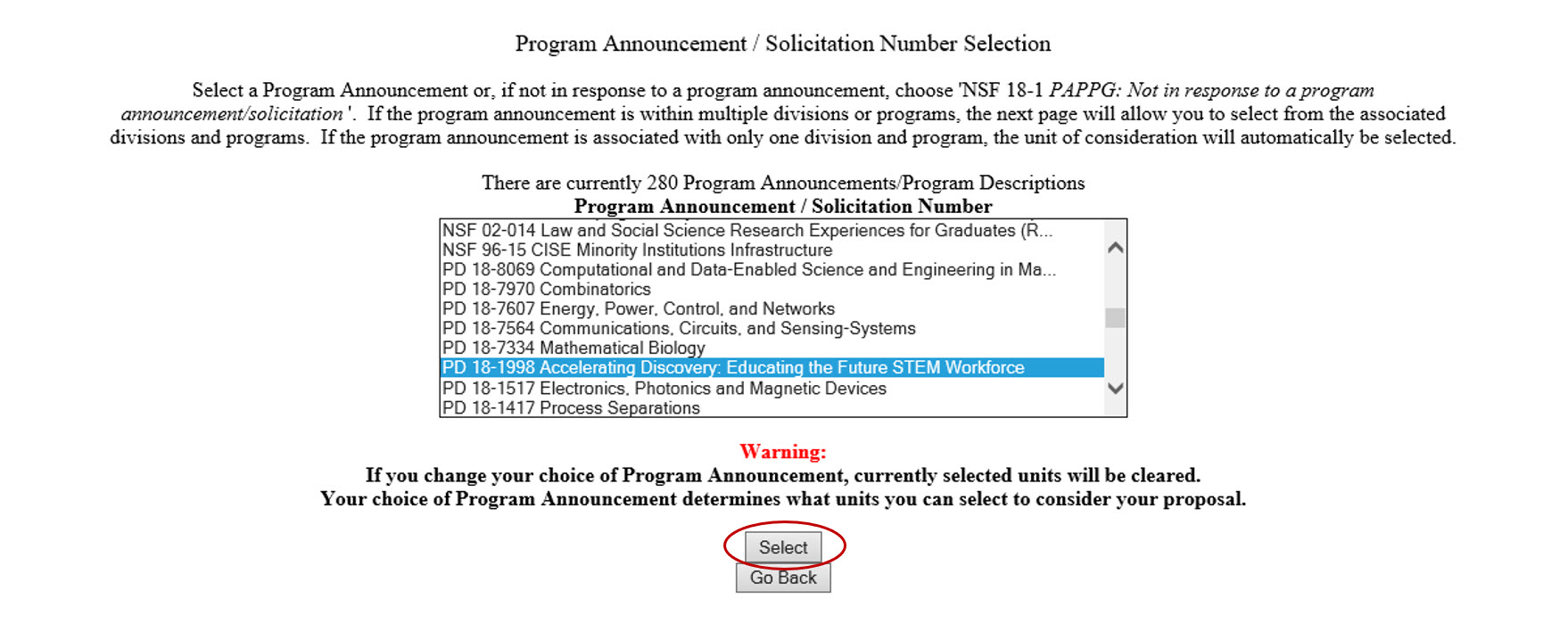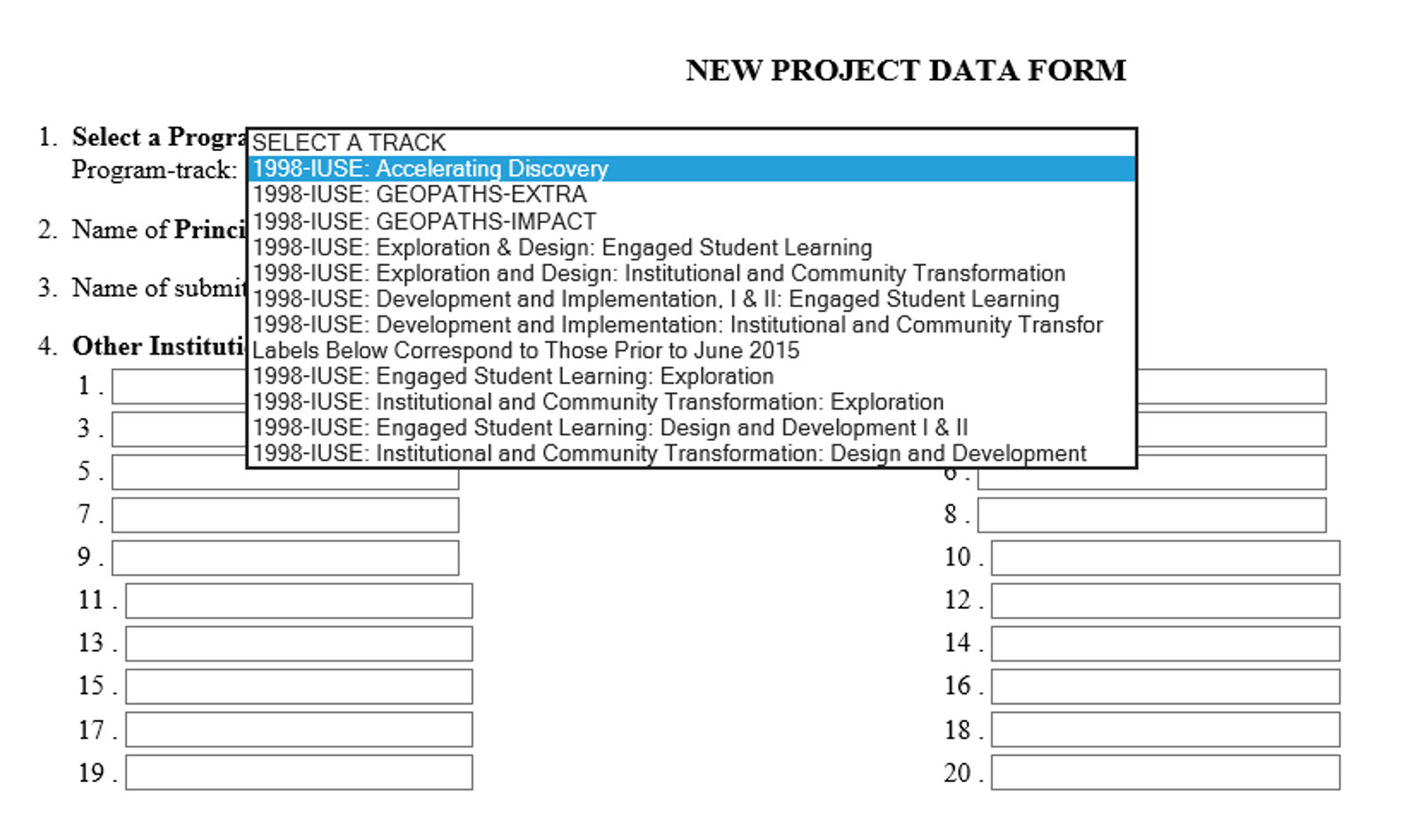This document has been archived.
NSF 18-100Frequently Asked Questions (FAQs) for Accelerating Discovery: Educating the Future STEM Workforce (AD) NSF PD 18-1998
- Does this program description replace any existing program solicitations or program announcements in EHR?
- What is a Program Description?
- What do I need to know to respond to a Program Description?
- What happens if I submit after the target date?
- Are there any identified categories or tracks?
- Is an (internal or external) advisory board required?
- Does the Program Description have an expectation for dissemination of project findings?
- Does the Program Description have an expectation for evaluation of project findings?
- May I submit letters of collaboration?
- May I submit letters of support?
- Are appendices allowed?
- Is the Project Description still limited to 15 pages?
- How many proposals may I submit?
- Are there any budget limits?
- How much overall funding is available for proposals to the Accelerating Discovery program description?
- Does the Accelerating Discovery program description allow proposals for five years of funding?
- What are "unsolicited" proposals? Are all proposals "unsolicited"?
- I was preparing a proposal in response to another program's solicitation and then learned about the AD program description. Can I submit the proposal I have been preparing to the AD program description?
- Can I apply for laboratory equipment that is integral to the project?
- Must a project be evidence-based or evidence-generating?
- Do I need to present baseline data and a theory of change?
- Do I need to include a Data Management Plan with my proposal?
- Do I need to include a Postdoctoral Researcher Mentoring Plan with my proposal?
- How do I start to prepare a proposal/application for this funding opportunity?
Does this program description replace any existing program solicitations or program announcements in EHR?
No.
What is a Program Description?
Chapter I.C (Categories of Funding Opportunities) of the NSF Proposal and Award Policies and Procedures Guide (PAPPG) provides a definition for a "Program Description."
What do I need to know to respond to a Program Description?
Proposals submitted in response to the Accelerating Discovery (AD) program description should follow the PAPPG's proposal preparation instructions, as described in Chapter II of that document. Specific guidelines appear regarding the Proposal Contents. Complete proposals expedite review and processing. To assure that research and other proposals submitted to the Foundation are complete, an administrative check should be made before submission (see the PAPPG Checklist for Proposal Preparation).
What happens if I submit after the target date?
According to the PAPPG, target dates are "dates after which proposals will still be accepted, although they may miss a particular panel or committee meeting." Proposals received by the target date will be considered for FY 2018 or FY 2019 funding.
Are there any identified categories or tracks?
No, there are no categories or tracks in the Program Description.
Is an (internal or external) advisory board required?
An advisory board (either internal or external) is not required. However, they may be useful and appropriate for many projects, particularly those that are large and more complex. If funds are requested for such a board, it would be helpful to describe the nature and function of the board and the types of people you would appoint to such a board. It can also be helpful to reviewers if you provide the names and expertise of specific people who have agreed to serve.
Does the Program Description have an expectation for dissemination of project findings?
Yes. The spread of the use of effective approaches to STEM education relies on outreach to the community, including presentation at professional society meetings, conferences, publication, and other mechanisms. See also PAPPG Chapter XI.D.4 which contains NSF's policy on the dissemination and sharing of research results.
Does the Program Description have an expectation for evaluation of project findings?
Yes. See the third of the merit review principles in the PAPPG.
May I submit letters of collaboration?
Yes. For specific guidance on the "documentation of collaborative arrangements of significance to the proposal," see PAPPG Chapter II.C.2.d.(iv) and PAPPG Chapter II.C.2.j.
May I submit letters of support?
No. See additional guidance in PAPPG Chapter II.C.2.j that appears under the section on "documentation of collaborative arrangements of significance to the proposal."
Are appendices allowed?
No. See PAPPG Chapter II.C.2.k.
Is the Project Description still limited to 15 pages?
Yes, per PAPPG Chapter II.C.2.d(ii).
How many proposals may I submit?
The Program Description does not include a limit on the number of proposals submitted.
Are there any budget limits?
The Program Description does not include any budget limits.
How much overall funding is available for proposals to the Accelerating Discovery program description?
There is no fixed allocation of funds for "AD." However, individual budgets for proposed projects should be appropriate to the scope and scale of the proposed activities.
Does the Accelerating Discovery program description allow proposals for five years of funding?
This section of the PAPPG Chapter Ii.C.2.a(4)(b) provides guidance on the duration of projects.
What are "unsolicited" proposals? Are all proposals "unsolicited"?
All proposals submitted to the Accelerating Discovery program are considered "unsolicited" because they are in response to a program description, not in response to a program solicitation.
I was preparing a proposal in response to another program's solicitation and then learned about the AD program description. Can I submit the proposal I have been preparing to the AD program description?
You could submit such a proposal being prepared for another program solicitation to the AD program description. However, you may not submit duplicate proposals. The PI team should take into consideration whether the structure of the proposed project meets the goal of the Accelerating Discovery: Educating the Future STEM Workforce program. As the AD Program Description notes: "EHR is particularly interested in supporting innovative education research and development in two Big Ideas: The Future of Work at the Human-Technology Frontier (FW-HTF) and Harnessing the Data Revolution for 21st Century Science and Engineering (HDR)."
Can I apply for laboratory equipment that is integral to the project?
Please follow the guidance in PAPPG Chapter II.C.2.g(iii).
Must a project be evidence-based or evidence-generating?
Both. As per the Program Description:
"Proposals should describe projects that build on available evidence and theory, and that will generate evidence and build knowledge, while contributing to the education of the future STEM workforce."Do I need to present baseline data and a theory of change?
If the rationale for your project and the basis and execution of its activities can be illuminated by such data or any other data or information, then you may provide it, but it is not required.
Do I need to include a Data Management Plan with my proposal?
Yes. For guidance see PAPPG Chapter II.C.2.j and PAPPG Chapter XI.D.4.
Do I need to include a Postdoctoral Researcher Mentoring Plan with my proposal?
Yes. If you are requesting support for postdoctoral researchers, see PAPPG Chapter II.C.2.j.
How do I start to prepare a proposal/application for this funding opportunity?
You may use either FastLane or Grants.gov to apply. You may also use the new Proposal Preparation System in Research.gov to apply. However, only FastLane may be used for Collaborative Proposals from multiple organizations. Instructions for using FastLane and Research.gov are available via the "Help" links at the top of the FastLane and Research.gov home pages. NSF-specific guidance for using Grants.gov is available in the NSF Grants.gov Application Guide>.
If you use FastLane: After you log in, in the Proposals, Awards & Status section, select "Proposal Functions" and then "Proposal Preparation," and begin to prepare a new proposal. On the proposal Cover Sheet, for the Program Announcement/Solicitation Number, search for PD 18-1998 in the pull-down menu of options. The menu contains dozens of options; the section with "PD" (Program Description) numbers is toward the bottom:
(Selecting PD 18-1998 will produce the correct NSF Unit Selection for the Cover Sheet.) When completing the remainder of the Cover Sheet, for the Deadline/Target Date, select "Target Date 07/02/2018" if you intend to submit the proposal before that target date. For later submissions, select "Window 01/16/2019." For the Type of Proposal, select "Research."
If you use Research.gov: After you log in, in the Prepare & Submit Proposals section, select the "Prepare Proposal" option and begin to prepare a new proposal. For the Funding Opportunity, search for PD 18-1998 in the list and select it. For the Proposal Type, select "Research." For the Submission Type, select "Full Proposal." For the Due Date, select "01/16/2019 (Window)."
If you use Grants.gov: Search for Opportunity Number PD-18-1998 and complete the associated Application Package. On Form SF424 (R & R), for the Type of Submission, select "Application," and for the "Type of Application," select "New." On the NSF Cover Sheet, enter the following for the NSF Unit Consideration:
Division Code (required): 11040000
Division Name: Division of Undergraduate Education
Program Code (required): 1998
Program Name: IUSEFor the Type of Proposal, select "Research."
The DUE Project Data Form must be submitted as part of every proposal/application. In FastLane, after you have completed and saved the Cover Sheet as described above, the Project Data Form will automatically appear in the Form Preparation menu along with all other proposal forms. However, the Project Data Form is not available in Grants.gov or Research.gov.
If you use Grants.gov or Research.gov, you must prepare and submit the Project Data Form separately in FastLane after you have submitted your proposal to NSF. Specifically, use FastLane's Proposal File Update module to prepare and submit that form. (Log into FastLane, and in the Proposals, Awards & Status section, select "Proposal Functions" and then "Proposal File Update.") In the "Proposal Update Justification Note," explain that the DUE Project Data Form could not be submitted via Grants.gov or Research.gov.
At the top of the Project Data Form, be sure to select the correct Program Track for the "Accelerating Discovery" opportunity ("1998-IUSE: Accelerating Discovery"), as shown here:

Program Officers to whom questions may be addressed, grouped by NSF's six "Big Ideas" for research and by other related themes. Disciplinary backgrounds appear parenthetically, and contacts may appear in more than one area.
Future of Work at the Human-Technology Frontier
Alex Medina-Borja: amedina@nsf.gov (Engineering)
Stephanie August: saugust@nsf.gov (Computer Science)
Sandra Richardson: srichard@nsf.gov (Mathematics)
Harnessing the Data Revolution
Stephanie August: saugust@nsf.gov (Computer Science)
Abby Ilumoka: ailumoka@nsf.gov (Engineering)
Mark Pauley: mpauley@nsf.gov (Biology/Computer Science)
Talitha Washington: twashing@nsf.gov (Mathematics)
Navigating the New Arctic
Lisa Rom: elrom@nsf.gov (Geosciences)
Windows on the Universe: The Era of Multi-Messenger Astrophysics
Corby Hovis: chovis@nsf.gov (Physics/Astronomy)
Steve Turley: rturley@nsf.gov (Physics)
The Quantum Leap: Leading the Next Quantum Revolution
Dawn Rickey: drickey@nsf.gov (Chemistry)
Abby Ilumoka: ailumoka@nsf.gov (Engineering)
Steve Turley: rturley@nsf.gov (Physics)
Understanding the Rules of Life: Predicting Phenotype
Ellen Carpenter: elcarpen@nsf.gov (Biology)
Celeste Carter: vccarter@nsf.gov (Biology)
Rupa Iyer: riyer@nsf.gov (Biology)
Mark Pauley: mpauley@nsf.gov (Biology/Computer Science)
Pushpa Ramakrishna: pusramak@nsf.gov (Biology)
Clytrice Watson: clwatson@nsf.gov (Biology)
Skilled Technical Workforce Development
Celeste Carter: vccarter@nsf.gov (Biology)
Pushpa Ramakrishna: pusramak@nsf.gov (Biology)
Heather Watson: hwatson@nsf.gov (Engineering)
Graduate/Early Career Workforce Development
Laura Regassa: lregassa@nsf.gov (Biology)
Kathleen Bergin: kbergin@nsf.gov (Biology)
Rupa Iyer: riyer@nsf.gov (Biology)
Karen Keene: kkeene@nsf.gov (Mathematics)
Institutional Change
Andrea Nixon: anixon@nsf.gov (Social Science)
Myles Boylan: mboylan@nsf.gov (Economics/Social Science)
Connie Della-Piana: cdellapi@nsf.gov (Evaluation/Social Science)
Interdisciplinarity/Convergence
Abby Ilumoka: ailumoka@nsf.gov (Engineering)
Corby Hovis: chovis@nsf.gov (Physics/Astronomy)
Rupa Iyer: riyer@nsf.gov (Biology)
Pushpa Ramakrishna: pusramak@nsf.gov (Biology)
Heather Watson: hwatson@nsf.gov (Engineering)
Teacher Workforce Development
Kathleen Bergin: kbergin@nsf.gov (Biology)
Karen Keene: kkeene@nsf.gov (Mathematics)
Sandra Richardson: srichard@nsf.gov (Mathematics)


